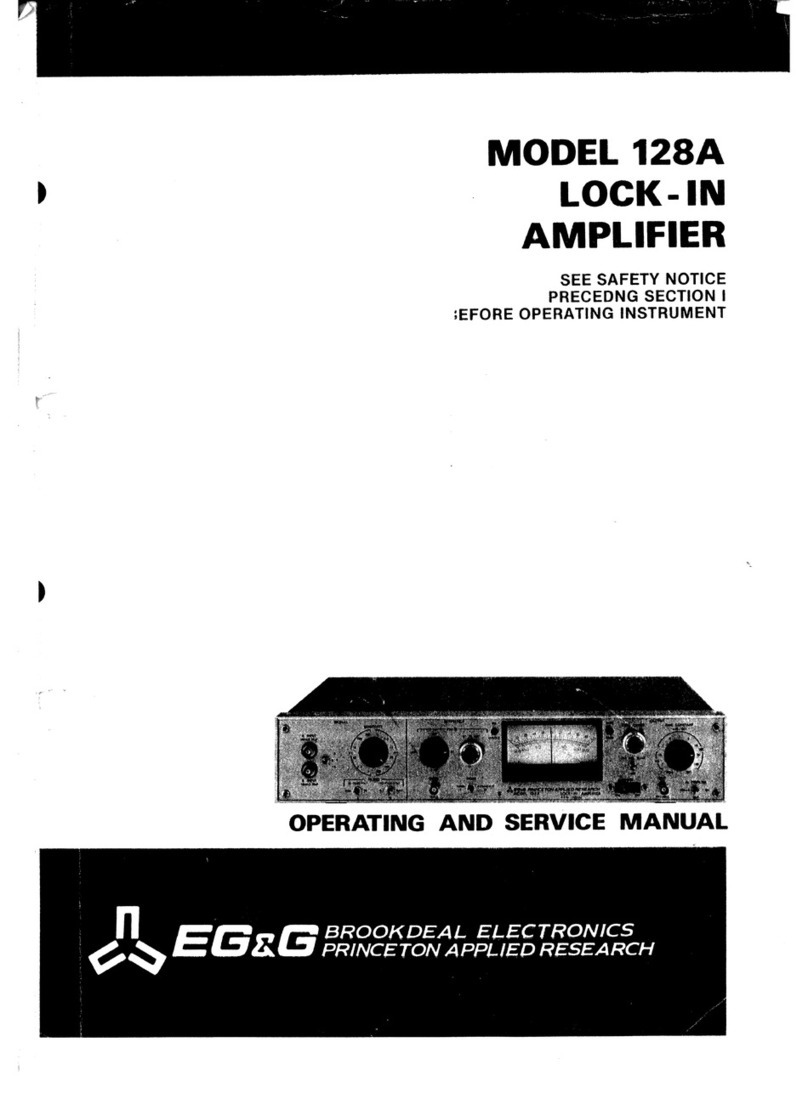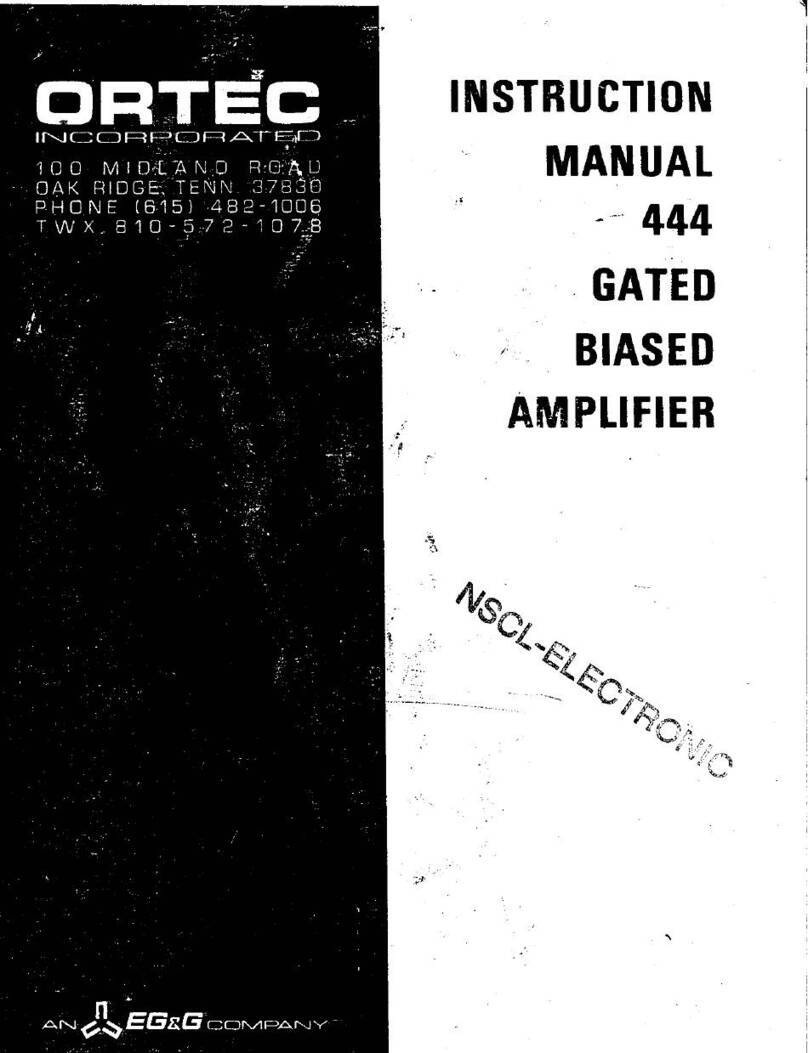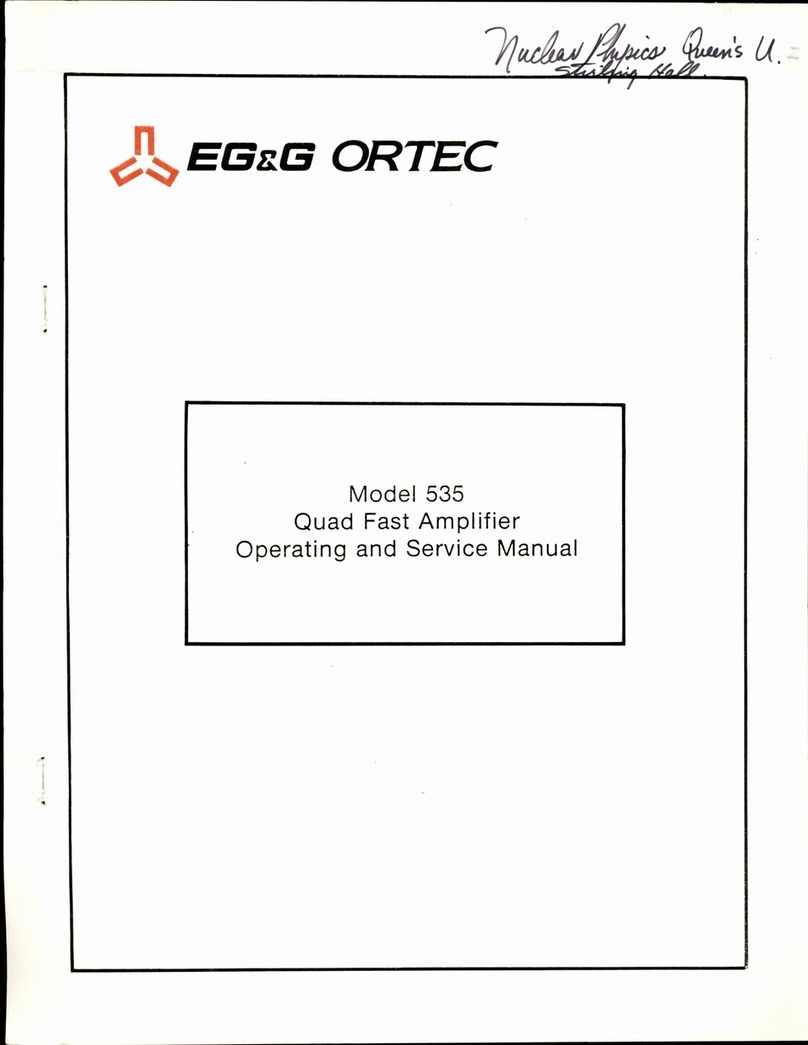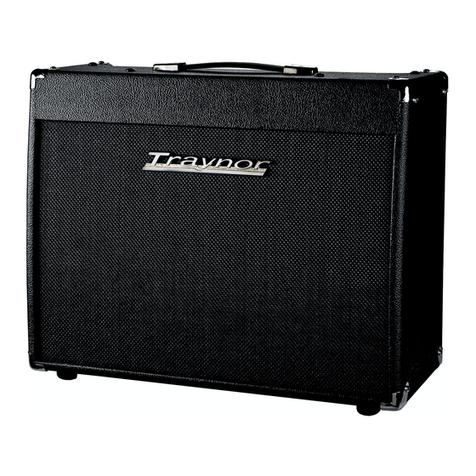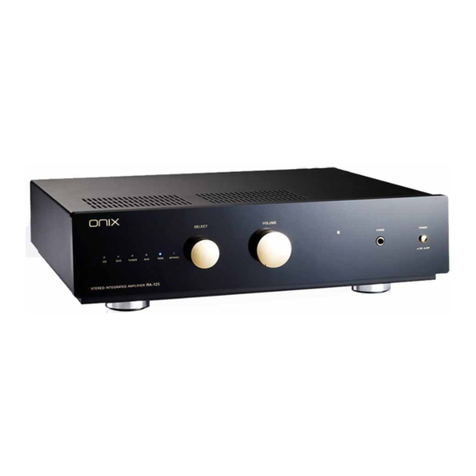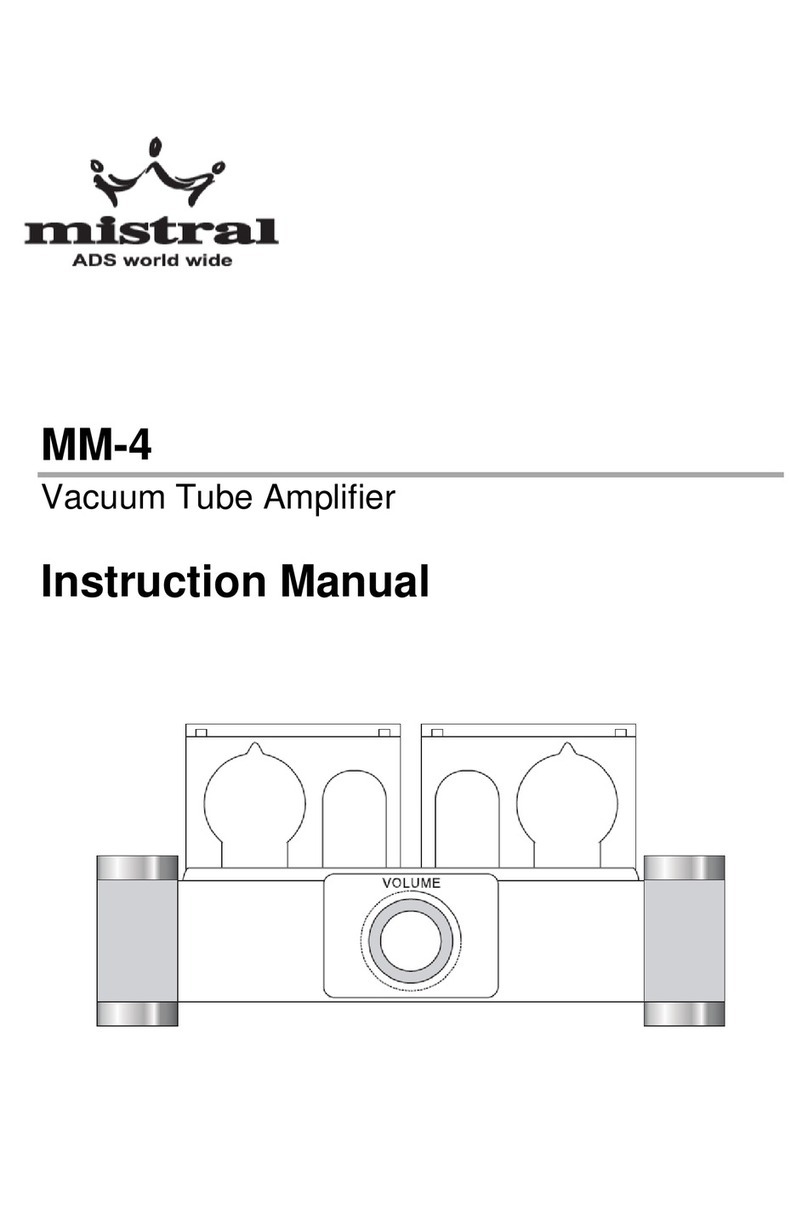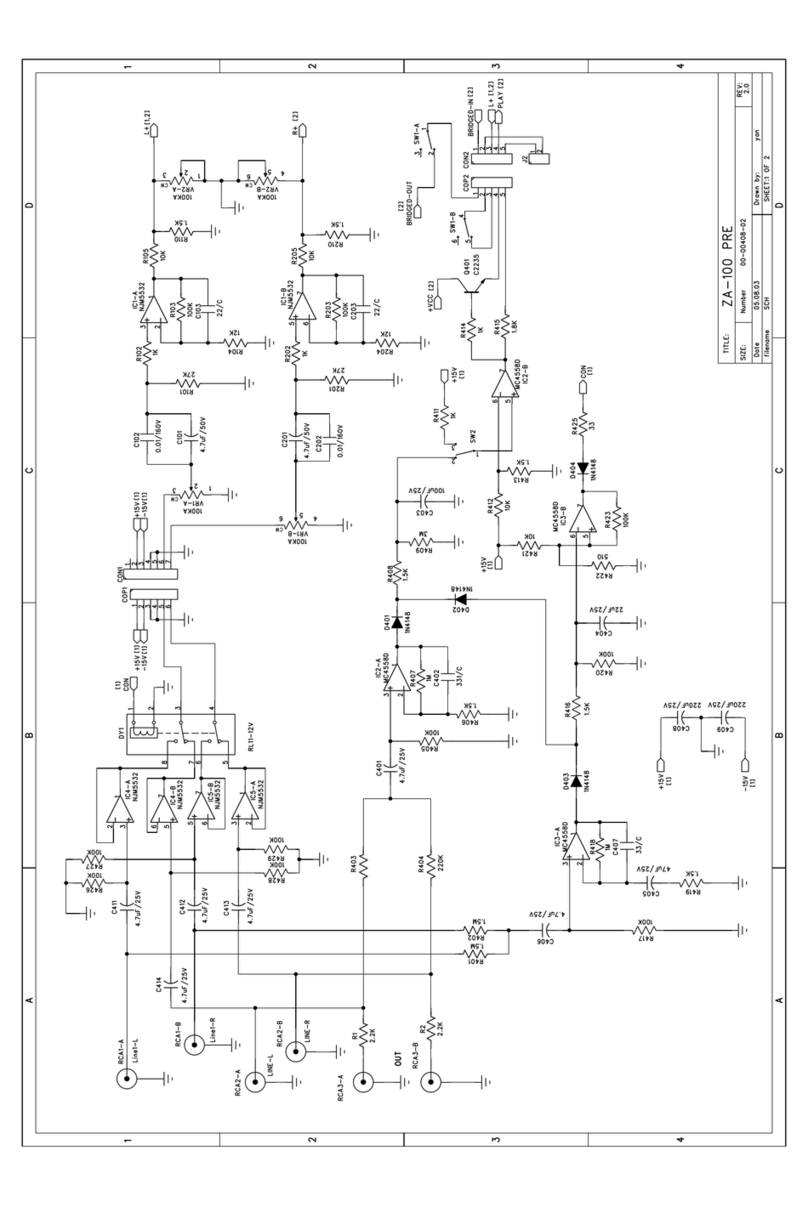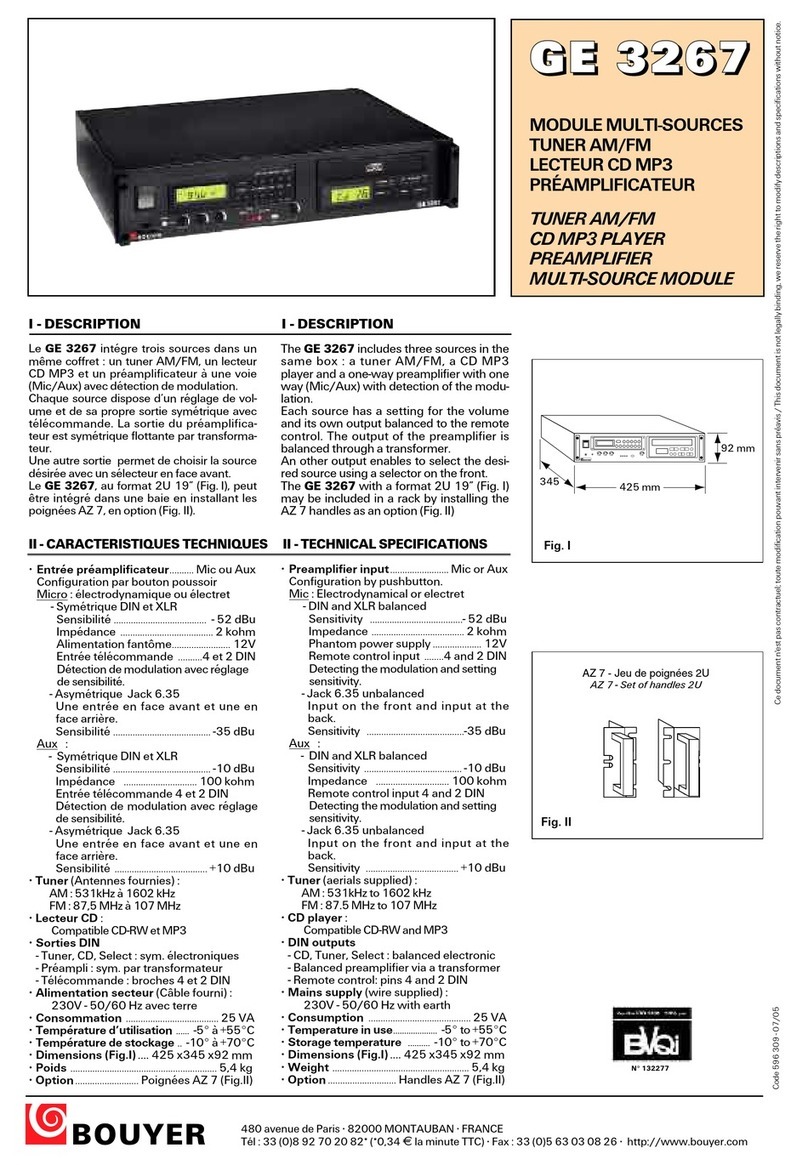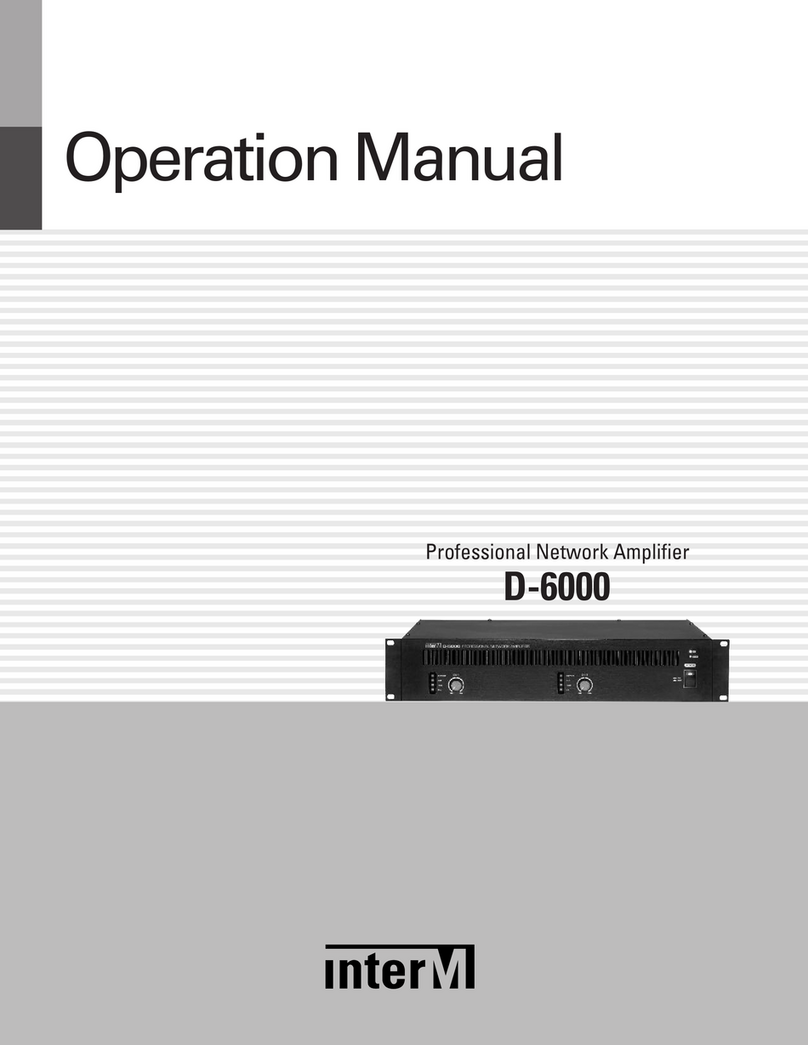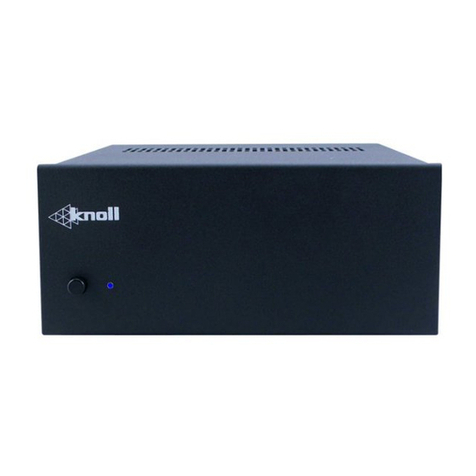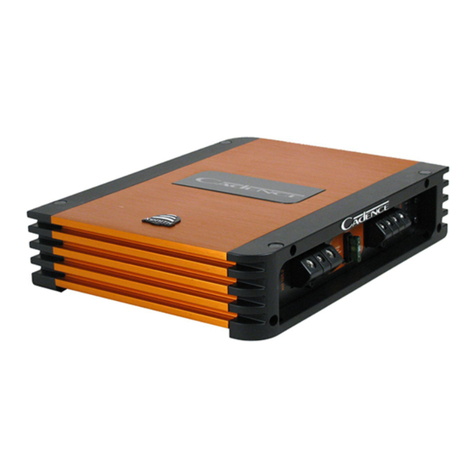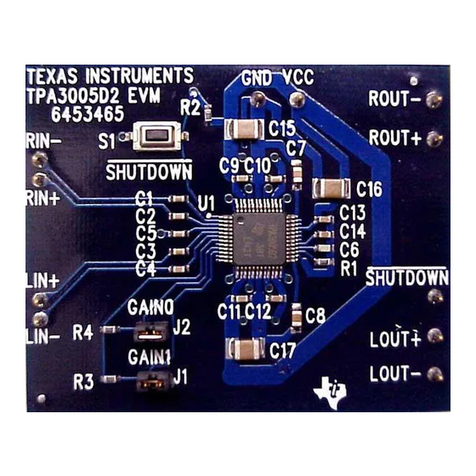EG&G ORTEC 474 Service manual

n
Model
474
Tinning
Filter
Amplifier
Operating
and
Service
Manual

Model
474
Timing
Filter
Amplifier
Operating
and
Service
Manual
This
manual
applies
to
instruments
marked
"Rev
12"
on
rear
panel
Printed
in
U.S.A.
2946
02C
0979

STANDARD
WARRANTY
FOR
EG&G
ORTEC
INSTRUMENTS
EG&G
ORTEC
warrants
that
the
items
will
be
delivered
free
from
defects
in
material
or
workmanship.
EG&G
ORTEC
makes
no
other
warranties,
express
or
implied,
and
specifically
NO
WARRANTY
OF
MERCHANTABILITY
OR
FITNESS
FOR
A
PARTICULAR
PURPOSE.
EG&G
ORTEC's
exclusive
liability
is
limited
to
repairing
or
replacing
at
EG&G
ORTEC's
option,
items
found
by
EG&G
ORTEC
to
be
defective
in
workmanship
or
materials
within
one
year
from
the
date
of
delivery.
EG&G
ORTEC
s
liability
on
any
claim
of
any
kind,
including
negligence,
loss
or
damages
arising
out
of,
connected
with,
or
from
the
performance
or
breach
thereof
or
from
the
manufacture,
sale,
delivery,
resale,
repair,
or
use
of
any
item
or
services
covered
by
this
agree
ment
or
purchase
order,
shall
in
no
case
exceed
the
price
allocable
to
the
item
or
service
furnished
or
any
part
thereof
that
oives
rise
to
the
claim.
In
the
event
EG&G
ORTEC
fails
to
manufacture
or
deliver
items
called
for
in
this
agreement
or
purchase
order
EG&G
ORTEC's
exclusive
liability
and
buyer's
exclusive
remedy
shall
be
release
of
the
buyer
from
the
obligation
to
pay
the
purchase
price.
In
no
event
shall
EG&G
ORTEC
be
liable
for
special
or
consequential
damages.
QUALITY
CONTROL
Before
being
approved
for
shipment,
each
EG&G
ORTEC
instrument
must
pass
a
stringent
set
of
quality
control
tests
designed
to
expose
any
flaws
in
materials
or
workmanship.
Permanent
records
of
these
tests
are
maintained
for
use
in
warranty
repair
and
as
a
source
of
statistical
information
for
design
improvements.
REPAIR
SERVICE
If
it
becomes
necessary
to
return
this
instrument
for
repair,
it
is
essential
that
Customer
Services
be
contacted
in
advance
of
its
return
so
that
a
Return
Authorization
Number
can
be
assigned
to
the
unit.
Also,
EG&G
ORTEC
must
be
informed,
either
in
writing
or
by
telephone
[(615)
482-4411],
of
the
nature
of
the
fault
of
the
instrument
being
returned
and
of
the
model,
serial,
and
revision
("Rev"
on
rear
panel)
numbers.
Failure
to
do
so
may
cause
unnecessary
delays
in
getting
the
unit
repaired.
The
EG&G
ORTEC
standard
procedure
requires
that
instruments
returned
for
repair
pass
the
same
quality
control
tests
that
are
used
for
new-production
instruments.
Instruments
that
are
returned
should
be
packed
so
that
they
will
withstand
normal
transit
handling
and
must
be
shipped
PREPAID
via
Air
Parcel
Post
or
United
Parcel
Service
to
the
nearest
EG&G
ORTEC
repair
center.
The
address
label
and
the
package
should
include
the
Return
Authorization
Number
assigned.
Instruments
being
returned
that
are
damaged
in
transit
due
to
inadequate
packing
will
be
repaired
at
the
sender's
expense,
and
it
will
be
the
sender's
responsibility
to
make
claim
with
the
shipper.
Instruments
not
in
warranty
will
be
repaired
at
the
standard
charge
unless
they
have
been
grossly
misused
or
mishandled,
in
which
case
the
user
will
be
notified
prior
to
the
repair
being
done.
A
quotation
will
be
sent
with
the
notification.
DAMAGE
IN
TRANSIT
Shipments
should
be
examined
immediately
upon
receipt
for
evidence
of
external
or
concealed
damage.
The
carrier
making
delivery
should
be
notified
immediately
of
any
such
damage,
since
the
carrier
is
normally
liable
for
damage
in
shipment.
Packing
materials,
waybills,
and
other
such
documentation
should
be
preserved
in
order
to
establish
claims.
After
such
notification
to
the
carrier,
please
notify
EG&G
ORTEC
of
the
circumstances
so
that
assistance
can
be
provided
in
making
damage
claims
and
in
providing
replacement
equipment
if
necessary.

CONTENTS
Page
WARRANTY
PHOTOGRAPHS
1.
DESCRIPTION
1
2.
SPECIFICATIONS
.
i
2.1.
Performance
1
2.2.
Controls
1
2.3.
Input
2
2.4.
Outputs
2
2.5.
Electrical
and
Mechanical
2
3.
INSTALLATION
2
3.1.
General
2
3.2.
Connection
to
Power
2
3.3.
Input/Output
Connections
2
4.
OPERATING
INSTRUCTIONS
2
5.
CIRCUIT
DESCRIPTION
3
6.
MAINTENANCE
3
6.1.
Corrective
Maintenance
3
6.2.
Factory
Service
3
7.
APPLICATION
NOTES
4
7.1.
General
4
7.2.
Constant-Fraction
Timing
with
Germanium
Detectors
4
7.3.
Nanosecond
Fluorescence
Spectrometry
5
Schematic
474-0201-SI
ILLUSTRATIONS
Fig.
7.1.
Gamma-Gamma
Coincidence
System
Using
a
Plastic
Scintillator
and
and
a
Large
Ge(Li)
Coaxial
Detector
5
Fig.
7.2.
Nanosecond
Decay
Time
Fluorescence
Spectrometer
System
6
Fig.
7.3.
Lifetime
Spectrum
of
Quinine
Sulfate
in
Sulfuric
Acid
6

FILTER
RMP
COARSE
6AIN
FINE
6AtN
■-
•2*
.
INTEORATEInSCC
I
Q
■■■
..■
■■
:§^;r•
:^r''■
•v^
'
-;.V"

ORTEC
474
TIMING
FILTER
AMPLIFIER
1.
DESCRIPTION
The
ORTEC
474
Timing
Filter
Amplifier
is
a
NIM-standard
module
for
use
where
a
wide-band
fast,
variable
RC
filter
amplifier
with
high
drive
and
variable
gain
is
needed.
Fea
tures of
the
474
include
a
wide
gain-control
range,
sepa
rately
selectable
RC
integrate
and
differentiate
time
constants
in
the
nanosecond
region,
pole-zero
com
pensation,
and
drive
capability
sufficient
for
use
with
son
or
icon
systems.
The
input
signals
are
dc
coupled
into
an
impedance
of
about
icon.
The
acceptable
amplitude
range
for
the
linear
input,
to
retain
its
linearity,
is
Oto
±1
V.
The
474can
operate
with
an
input
dc
offset
where
the
maximum
total
input
signal
range,
including
the
offset,
does
not
exceed
the
limits
of
±5
V.
Input
signals
may
be
either
positive
or
negative
unipolar,
or
they
can
be
bipolar
with
either
a
positive
or
negative
lobe
leading.
The
output
polarity
can
be
switch-selected
to
either
duplicate
or
invert
the
input
polarity.
Protection
is
provided
for
input
voltages
of
up
to
±100
V
at
a
10%
duty
cycle
integrated
over
1
second.
The
gain
for
midband
frequencies
can
be
set
at
any
value
from
X2
through
X250,
using
six
coarse
gain
settings
and
a
fine
gain
control,
which
is
a
single-turn
potentiometer.
The
gain
factors
are
selected
to
provide
range
overlap
and
to
assure
continuously
adjustable
gain
control
through
out
the
full
range.
Two
6-posltlon
switches
permit
the
separate
selection
of
RC-integrate
and
RC-dlfferentlate
time
constants.
The
integrate
time
constant
can
deselected
from
10
ns
(switch
set
at
Out)
through
500
ns.
The
differentiate
time
constant
can
be
selected
from
20
ns
through
500
ns
or,
when
set
at
Out,
at
150
MS.
Thus
the
input
pulses
can
be
reshaped
to
provide
a
consistent
risetlme
and
decay
time
for
compati
bility
with
the
application
requirements.
The
linear
output
pulses
can
be
either
unlpolaror
bipolar,
depending
on
the
type
of
Input
pulses
that
are
furnished
to
the
474.
When
the
front
panel
toggle
switch
selects
Invert,
the
output
Is
the
opposite
polarity
to
the
input
or,
when
the
toggle
switch
selects
Noninvert,
the
polarities
are
the
same.
The
474
is
capable
of
driving
a
500
load
up
to
±5
V
with
no
degradation
of
the
performance
specifi
cations.
The
ORTEC
474
Timing
Filter
Amplifier
Is
a
NIM-standard
single-width
module;
the
front
panel
measures
1.35
by
8.714
In.,
which
is
in
accordance
with
TID-20893
(Rev).
It
is
intended
for
installation
and
operation
in
a
standard
enclosure,
suoh
as
the
ORTEC
401/402
Series
of
Bins
and
Power
Supplies.
The
module
accepts
all
of
its
required
operating
power
from
the
power
supply
that
Is
attached
to
the
bin.
2.
SPECIFICATIONS
2.1.
PERFORMANCE
INPUT
AMPLITUDE
RANGE
0
to
±1
V
linear
signal,
0
to
±5
V
offset,
maximum
input
±5
V
total.
OUTPUT
AMPLITUDE
RANGE
0
to
±5
V
linear
onto
a
50n
cable
and
load.
RISETIME
<10
ns
with
filter
Out,
or
-2.2
r,
for
other
Integrate
settings.
NOISE
For
maximum
gain,
rms
noise
referred
to
the
input
is
^10
mV
with
n
=
rd
=
200
ns,
or<50
mV
with
filter
Out;
measurements
made
with
an
HP
3400A
true
rms
meter.
NONLINEARITY
<±0.05%
at
midband
frequency
over
±5
V
range.
TEMPERATURE
INSTABILITY
DC
Level
<±25
mV/°0
referred
to
the
output.
Gain
<0.06%/°
0.
OPERATING
TEMPERATURE
RANGE
0
to
50°
C
(273
to
323
K).
2.2.
CONTROLS
COARSE
GAIN
Front
panel
6-posltion
switch
to
select
XI,
X2,
X4,
X6,
XI0,
or
X20
gain
factor.
FINE
GAIN
Front
panel
single-turn
potentiometer,
con
tinuously
adjustable
from
X2
to
XI
2.5.
POLE
ZERO
ADJUST
Front
panel
screwdriver
adjust
ment
to
cancel the
pole
associated
with
the
input
signal
such
as
that
derived
from
the
preamplifier
clipping
net
work.
DIFFERENTIATE
Front
panel
6-posltlon
switch
selects
a
differentiation
time
constant
to
control
the
decay
time
of
the
pulse;
settings
select
Out
(equivalent
to
150
ms),
20,
50,
100,
200,
or
500
ns.
INTEGRATE
Front
panel
6-posltlon
switch
selects
an
integration
time
constant
to
control
the
risetlme
of
the
pulse;
settings
select
20,
50,
100,
200,
or
500
ns
or
Out
(equivalent
to
10
ns).
Note;
With
DIff
and
Int
switches
both
at
Out,
passband
is
typically
1
kHz
to
35
MHz.

INVERT/NONINVERT
Front
panel
toggle
switch
selects
inversion
or
noninversipn
of
the
input
signal
polarity
for
the
polarity
of
the
output
signal.
2.3.
INPUT
INPUT
Front
panel
BNC
connector
accepts
input
pulses
of
either
polarity;
amplitude
0
to
±1
V,
protected
to
±6
V
dc
and
to
±100
V
at
10%
duty
cycle
integrated
over
1
second;
impedance
10011
dc
coupled.
Accepts
a
±5
V
dc
offset;
maximum
input
(signal
plus
offset)
limited
to
±5
V.
2.4.
OUTPUTS
OUTPUT
Front
panel
BNC
connector
furnishes
the
shaped
and
amplified
signal
through
Z.,u.
<in,
dc
cou
pled.
Amplitude
0
to
±5
V;
risetime
and
decay
time
con
trolled
by
Integrate
and
Differentiate
filter
settings.
PREAMP
POWER
Rear
panel
standard
ORTEG
power
connector,
Amphenol
type
17-10090.
2.5.
ELECTRICAL
AND
MECHANICAL
POWER
REQUIRED
+24
V,
56
mA;
-24
V,
37
mA;
+12
V,
102
mA;
-12
V,
121
mA.
DIMENSIONS
NIM-standard
single-width
module
(1.35
by
8.714
in.)
per
TID-28093
(Rev).
3.
INSTALLATION
3.1.
GENERAL
The
474
operates
on
power
that
must
be
furnished
from
a
nuclear-standard
bin
and
power
supply
such
as
the
ORTEG
401/402
Series.
The
bin
and
power
supply
is
de
signed
for
relay
rack
mounting.
If
the
equipment
is
to
be
rack
mounted,
be
sure
that
there
is
adequate
ventilation
to
prevent
any
localized
heating
of
the
components
that
are
used
in
the
474.
The
temperature
of
the
equipment
mounted
in
racks
can
easily
exceed
the
maximum
limit
of
50°
G
(323
K)
unless
precautions
are
taken.
3.2.
CONNECTION
TO
POWER
The
474
contains
no
internal
power
supply
and
must
obtain
the
necessary
dc
operating
power
from
the
bin
and
power
supply
in
which
it
is
installed
for
operation.
Always
turn
off
power
for
the
power
supply
before
inserting
or
removing
any
modules.
ORTEG
modules
are
designed
so
that
a
full
complement
of
modules
installed
in
the
bin
will
not
overload
the
NIM-standard
power
supply.
Since,
however,
this
may
not
be
true
when
the
bin
contains
mod
ules
other
than
those
of
ORTEG
design,
the
dc
power
levels
should
be
checked
after
all
of
the
modules
have
been
installed.
The
ORTEG
401/402
Series
Bins
and
Power
Supplies
have
convenient
test
points
on
the
power
supply
control
panel
to
permit
monitoring
these
dc
levels.
3.3.
INPUT/OUTPUT
CONNECTIONS
The
input
impedance
of
the
474
is
about
10011
and
pro
vides
a
suitable
termination
for
cable
with
a
characteristic
impedance
of
9311.
If
the
cable
that
is
used
for
the
input
signals
has
a
characteristic
impedance
of
50fl,
use
a
BNG
Tee
at
the
474
Input
to
accommodate
the
cable
and
a
10011
terminator;
the
terminator
and
the
input
impedance,
which
are
in
parallel,
will
then
match
the
5011
cable
im
pedance.
The
low
output
impedance
of
the
474
requires
that
the
output
cable
be
terminated
by
the
characteristic
imped
ance
of
the
cable
at
its
remote
end.
This
can
be
accom
plished
at
the
input
of
a
high-input
impedance
instrument
or
by
using
an
instrument
with
an
input
impedance
equal
to
the
impedance
of
the
cable.
Both
driving
end
and
re
ceiving
end
coaxial
line
termination
is
recommended
for
long
cables,
although
this
reduces
the
driving
amplitude
by
50%.
4.
OPERATING
INSTRUCTIONS
Either
of
two
functions,
or
both,
may
be
furnished
by
the
ORTEG
474
Timing
Filter
Amplifier,
depending
on
the
details
of
the
circuit
in
which
it
is
installed.
It
may
be
used
to
linearly
amplify
a
small
amplitude
range
into
one
that
is
better
suited
to
the
requirements
of
a
subsequent
instru
ment
in
the
system;
the
gain
can
be
set
at
any
level
from
X2
through
X250
for
this
purpose.
The
shaping
time
con
stants
that
select
integration
and
differentiation
circuits
in
the
474
can
be
set
to
normalize
a
pulse
rise
and
decay
time
to
optimize
timing
measurements.
In
addition
to
these
basic
functions,
the
474
can
also
be
used
to
invert
the
pulse
polarity
if
desired
and
to
correct
for
the
pole-
zero
effect
that
is
prov'ded
from
the
preamplifier
in
the
system.

There
are
no
typical
control
settings
that
can
be
sug
gested
for
operation,
since
each
application
of
the
474
will
require
a
different
combination
of
functions.
After
the
system
has
been
installed,
use
an
oscilloscope
to
observe
the
waveforms
at
the
input
and
output
of
the
474
and
adjust
its
controls
to
optimize
its
operation,
con
sidering
the
functions
that
are
required
of
it.
Generally
speaking,
the
Integrate
time
constant
can
be
selected
so
that
the
risetime
of
the
output
pulses
is
nor
malized
at
a
rate
that
is
slower
than
the
risetimes
of
the
input
pulses.
This
function
is
of
greatest
value
when
the
pulses
originate
in
a
large
detector
so
that
they
generate
a
wide
variety
of
risetimes
and
are
difficult
to
observe
for
timing
measurements.
The
Differentiate
time
constant
is
also
selectable
and
determines
the
total
interval
before
the
pulse
returns
to
the
baseline
and
allows
a
new
pulse
to
be
observed.
The
combination
of
integration
and
differ
entiation
time
constants
also
contributes
to
the
amount
of
electronic
noise
that
is
seen
in
the
system,
so
the
resulting
waveforms
should
be
considered
from
each
of
these
points
of
view
and
adjusted
for
optimum
results.
When
the
shaping
time
constants
impose
considerable
changes
in
the
input
waveform,
the
nominal
gain,
which
is
the
product
of
the
Coarse
and
Fine
control
settings,
may
be
degraded
somewhat.
This
is
not
normally
a
pro
blem,
since
the
gain
is
constant
even
though
it
may
be
less
than
the
nominal
settings
indicate.
5.
CIRCUIT
DESCRIPTION
The
circuit
of
the
ORTEC
474
Timing
Filter
Amplifier
is
shown
in
schematic
474-0201-S1,
included
at
the
back
of
this
manual.
The
front
panel
toggle
switch,
SI,
selects
a
resistance
network
for
Invert
or
a
circuit
through
Q.1
and
Q2
for
Non-
invert
for
pulses
of
either
polarity,
and
the
pulses
are
then
furnished
into
the
differentiation
network
at
82.
If
82
is
set
at
Out,
the
input
pulse
is
coupled
through
R34
to
the
input
of
A1.
The
pole-zero
adjustment,
R30,
does
not
pro
vide
any
effect
for
the
Out
setting
of
82.
If
82
is
set
at
any
of
its
other
five
positions,
the
input
pulse
is
coupled
through
a
capacitor
that
is
in
parallel
with
a
portion
of
the
signal,
furnished
through
the
pole-zero
circuit,
and
pro
vided
to
the
input
of
A1.
Amplifier
A1
is
an
ORTEC
Hybrid
circuit,
type
HBA0106,
that
includes
Coarse
Gain
control
83.
The
amplified
out
put
at
pin
5
of
At
is
furnished
to
the
integration
network
at
the
input
to
A2,
which
is
another
type
HBA0106
ORTEC
Hybrid
circuit.
Amplifier
A2
has
a
gain
that
is
adjusted
by
Fine
Gain
con
trol
R64.
The
output
of
A2
is
furnished
to
the
base
of
09,
which
is
the
input
of
the
output
voltage
amplifier.
The
out
put
voltage
amplifier,
consisting
of
transistors
09
through
Q20
and
associated
resistors
and
capacitors,
has
a
volt
age
gain
of
approximately
5.
A
complementary
Darlington
output
stage
is
used
to
provide
good
bipoiar
drive
capa
bility.
Potentiometer
R100
is
a
factory-adjusted
balance
control
for
the
two
halves
of
the
complementary
Darling
ton
output
stage.
Integrated
circuit
101
senses
the
output
at
CN2
and
acts
in
the
dc
feedback
loop
to
force
the
output
to
zero.
IC1
is
connected
as
an
integrator,
with
a
time
constant
of
ap
proximately
150
IJ.S
(corresponding
to
about
1
kHz).
The
NIM
power
connector
includes
circuits
that
accept
±12
V
and
±24
V.
These
input
power
levels
are
filtered
and
are
used
internally
in
the
circuits
of
the
474.
The
four
leveis
are
also
furnished
through
the
rear
panel
Preampli
fier
Power
connector,
CN4,
and
can
be
used
as
the
power
source
for
an
associated
ORTEC
preamplifier.
6.
MAINTENANCE
6.1.
CORRECTIVE
MAINTENANCE
The
ORTEC
474
should
require
no
regular
maintenance
other
than
replacement
of
components
that
have
failed
due
to
age.
Always
ensure
that
the
replacement
compo
nents
are
equivalent
to
the
original
parts,
designated
in
schematic
474-0201-81.
No
internal
trimming
or
adjust
ment
is
necessary
for
the
474.
To
aid
in
the
identification
of
a
malfunctioning
compo
nent,
typical
dc
voltages
are
listed
in
Table
6.1.
Note
that
these
are
typical
values,
and
may
vary
from
one
unit
to
another
without
indicating
a
fault.
6.2.
FACTORY
SERVICE
This
instrument
can
be
returned
to
the
ORTEC
factory
for
service
and
repair
at
a
nominal
cost.
The
ORTEC
standard
procedure
for
repair
ensures
the
same
quaiity
control
and
checkout
that
are
used
for
a
new
instrument.
Always
contact
Customer
8ervices
at
ORTEC,
(615)
482-
4411,
before
sending
in
an
instrument
for
repair
to
obtain
shipping
instructions
and
so
that
the
required
Return
Authorization
Number
can
be
assigned
to
the
unit.
This
number
should
be
written
on
the
address
label
and
on
the
package
to
ensure
prompt
attention
when
it
reaches
the
factory.

n
Table
6.1.
Typical
dc
Voltages
NONINV
mode;
Diff
and
Int
switches
set
to
"Out";
Fine
Gain
2;
Coarse
Gain
=
1.
Q1B
-2.7
mV
018E
-29
mV
Q1E
-0.6
V
019B
8.65
V
QIC
12.0
V
0190
11.70
V
Q2B
45
mV
O20B
-8.65
V
020
5.90
V
O20O
-11.70
V
03E
5.35
V
101(2)
-2.6
mV
Q4B
-6.76
V
101(3)
-2.2
mV
Q4E
-7.40
V
101(4)
-12
V
Q5B
-7.40
V
101(6)
-70
mV
Q6E
-7.30
V
101(7)
12
V
07B
14.50
V
A1(1)
100
mV
Q7E
13.95
V
A1(2)
120
mV
Q8E
14.55
V
A1(3)
-0.50
V
Q9B
90
mV
A1(4)
17
mV
Q9E
0.73
V
A1(5)
0
mV
090
-9.25
V
A1(6)
-11.5
V
O10B
7.60
V
A1(7)
-5.8
V
O10E
8.25
V
A1(8)
0
V
011B
8.20
V
A1(9)
0.65
V
0110
12.0
V
A1(lb)
11.7V
012E
8.20
V
A2(1)
-17
mV
0120
1.27
V
A2(2)
-1.0
mV
013E
1.21
V
A2(3)
-0.6
V
0130
-1.25
V
A2(4)
40
mV
014E
-9.85
V
A2(5)
-56
mV
0140
-1.31
V
A2(6)
-11.5
V
015E
0.66
V
A2(7)
-5.8
V
0150
8.0
V
A2(8)
0
V
016E
25
mV
A2(9)
0.77
V
017E
-0.68
V
A2(10)
11.7
V
0170
-8.0
V
7.
APPLICATION
NOTES
7.1.
GENERAL
The
most
important
function
that
is
served
by
the
474
Timing
Filter
Amplifier
is
pulse
shaping.
This
is
especially
important
when
using
the
output
from
a
large
volume
de
tector,
with
a
wide
range
of
charge-collection
times
for
its
output
pulses,
and
attempting
to
obtain
timing
infor
mation
from
these
nonuniform
pulses.
By
adjusting
the
pulse
risetime
with
the
474
to
an
interval
that
is
longer
than
any
of
the
input
risetimes,
the
474
output
pulses
will
have
the
advantage
of
uniformity.
The
pulse
decay
time
constant
is
also
selectable
so
that
the
operator
can
com
promise
between
pulse-pair
resolution
time
and
system
noise;
as
shorter
time
constants
are
used,
pulse-pair
resolution
time
is
shortened
at
the
expense
of
an
increase
in
noise.
Other
functions
that
are
also
included
in
the
474
are
linear
amplification
of
small
pulses
of
either
polarity,
polarity
control,
and
adjustable
pole-zero
cancellation.
These
additional
features
provide
useful
functions
in
most
of
the
circuits
where
pulse
shaping
is
necessary.
Each
application
for
the
474
will
require
a
different
com
bination
of
the
data
enhancement
parameters
that
are
available.
Use
each
as
required
in
the
specific
application.
7.2.
CONSTANT-FRACTION
TIMING
WITH
GERMANIUM
DETECTORS
Figure
7.1
is
a
block
diagram
of
a
gamma-gamma
coin
cidence
sy.stem
that
can
be
used
for
timing
with
germa
nium
detectors.
In
this
system
the
TPHC
start
channel

456
HIGHVOLTAGE
POWERSUPPLY
1-bv
1-
in.
KL236
459
DETECTOR
BIAS
SUPPLY
265
PM
BASE
RCA
8575
PM
TUBE
Anode
11
SCINTIL
PREAMI
3
LATION
'LIFIER
1
r
460
OELAY-LINE
AMPLIFIER
473A
CONSTANT-
FRACTION
DISCRIMINATOR
^^Na
Source
*
425A
NANOSECOND
DELAY
GeaO
COAXIAL
DETECTOR
473A
CONSTANT-
FRACTION
DISCRIMINATOR
120-4
PREAMPLIFIER
474
TIMING
FILTER
AMPLIFIER
Start
^
f
^
Stop
TIMING
SCA
457
TIME-TO
PULSE
HEIGHT
CONVERTER
414A
FAST
COINCIDENCE
j
551
TIMING
SCA
460
OELAY'LINE
AMPLIFIER
6240B
MULTICHANNEL
ANALYZER
8169
Fig.
7.1.
Gamma-Gamma
Coincidence
System
Using
a
Piastic
Scintiilator
and
a
Large
Ge(Li)
Coaxial
Detector.
uses
a
fast
plastic
scintiilator
and
the
stop
channel
uses
a
coaxial
germanium
detector.
Excellent
timing
spectra
have
been
obtained
by
combining
the
pulse
shaping
avail
able
with
the
474
together
with
the
use
of
the
slow-rise-
time
(SRT)
reject
circuitry
in
the
constant-fraction
dis
criminator.
The
SRT
circuitry
is
most
effective
when
used
with
a
wide
dynamic
range
of
energies.
It
can
provide
dramatic
improvement
in
timing
resolution
below
the
FWHM
level
and
makes
reliable
timing
data
possible
at
even
the
FW(1/100)M
level.
The
SRT
circuitry
in
the
constant-fraction
discriminator
can
provide
improved
timing
resolution
by
rejecting
those
logic
pulses
that
result
from
leading-edge
timing
in
the
instrument.
Since
the
input
signals
that
cause
leading-
edge
walk
represent
valid
energy
information,
use
of
the
SRT
circuitry
results
in
a
loss
in
the
counting
efficiency
of
the
system.
A
system
for
measuring
the
lifetimes
of
excited
states
at
extremely
low
energies
is
similar
to
the
system
shown
in
Fig.
7.1.
In
this
configuration
the
coaxial
Ge(Li)
detector
and
preamplifier
are
replaced
with
a
Ge(Li)
low-energy
photon
spectrometer
(LEPS)
detector
and
preamplifier.
7.3.
NANOSECOND
FLUORESCENCE
SPECTROMETRY
The
ORTEC
9200
Nanosecond
Fluorescence
Spectrom
eter
is
used
in
lifetime
measurements
of
excited
molecular
states.
In
the
specific
application
where
the
molecular
structure
is
studied,
the
experimenter
seeks
to
verify
a
complex
model
of
a
particular
molecule
or
to
determine
how
a
particular
molecule
is
altered
by
its
surroundings.
This
type
of
experiment
requires
that
the
total
efficiency,
the
exact
energy,
and
the
complete
time
function
involved
in
the
de-excitation
of
an
electronic
state
be
known
so
that
the
e,xperimental
results
can
be
fit
precisely
to
a
model.
Figure
7.2
shows
the
9200
System,
and
Fig.
7.3
shows
the
detailed
lifetime
characteristics
of
a
0.1
N
solution
of
quinine
sulfate
in
sulfuric
acid
that
was
excited
with
im
pulses
of
light
at
approximately
340
nm
with
the
9200
System.
The
quantity
of
information
available
from
such
a
lifetime
measurement
is
illustrated
by
this
set
of
data.

PUT
Aperture
Control
Puiser
Aperture
Control
'
9351
FLUORESCENCE
ORTEC
RCA
9201
8850
PHOTOMULTIPLIER
BASE
8.
TUBE
1
456
HIGH-VOLTAGE
POWER
SUPPLY
Stop
Channel
Linear
Channel
474
TIMING
FILTER
AMPLIFIER
SAMPLE
COMPARTMENTI
CUVETTE
ABC
C
8
-
A
9290
HIGH-VOLTAGE
POWER
SUPPLY
Start
Channel
A
-
Aperture
B
-
Filter
C
-
Polarizer
9352
Nanosecond
Light
Puiser
473A
CONSTANT-
FRACTION
DISCRIMINATOR
(Used
as
Ratio
Indicator)
DUAL
COUNTER/TIMER
Start
From
473A,
4890,
or
457
Data
Accumulation
Channel
473A
CONSTANT-
425A*
FRACTION
NAraUSECUNO
DISCRIMINATOR
DELAY
Stop
4890
PREAMPLIFIER/
AMP/SCA
457
BIASED
TIME-
TO-PULSE-
HEIGHT
CONVERTER
i
i
Ext. Strobe
DC
6240B
MULTICHANNEL
ANALYZER
"When
using
the
50-ns
time
range
of
the
457,
the425A
should
be
used
in
the
start
channel
rather
than
in
the
stop
channel.
8169a
Rg.
7.2.
Nanosecond
Decay
Time
Fluorescence
Spectrometer
System.
.
■
r
=
19.2n!
lOr
Fig.
7.3.
Lifetime
Spectrum
of
Quinine
Suifate
in
Sulfuric
Acid.

BIN/MODULE
CONNECTOR
PIN
ASSIGNMENTS
FOR
AEC
STANDARD
NUCLEAR
INSTRUMENT
MODULES
PER
TID-20893
Pin
Function
Pin
Function
1
+3
volts
23
Reserved
2
—3
volts
24
Reserved
3
Spare
Bus
25
Reserved
4
Reserved
Bus
26
Spare
5
Coaxial
27
Spare
6
Coaxial
*28
.
+24
volts
7
Coaxial
*29
—24
volts
8
200
volts
dc
30
Spare
Bus
9
Spare
31
Spare
•10
+6
volts
32
Spare
■11
—6
volts
*33
115
volts
ac
(Hot)
12
Reserved
Bus
*34
Power
Return
Ground
13
Spare
**35
Reset
(Sealer)
14
Spare
**36
Gate
15
Reserved
**37
Reset
(Auxiliary)
+12
volts
38
Coaxial
^17
—12
volts
39
Coaxial
18
Spare
Bus
40
Coaxial
19
Reserved
Bus
*41
115
volts
ac
(Neut.)
20
Spare
*42
High
Quality
Ground
21
Spare
G
Ground
Guide
Pin
22
Reserved
Pins
marked
{*)
are
installed
and
wired
in
ORTEC
401A
and 401
B
Modular
System
Bins.
Pins
marked
(*)
and
(**)
are
installed
and
wired
in
EG&G/ORTEC—HEP
M250/N
and
M350/N
NIMBINS,

OBTEC
^7^-0201C
-TrsT]-
/-EHIl-V
-Qty-
Hri
i«h-
«
-I
R'lS
-IR120I-
-TrtoI-
-I
R65I-
-CMD-
-TR67|-
—I
R
7
9"]—
^
Q
t
-I
R95>-
I I I
h-
-LR'7
©
I
j_
-OH}-
1$
-BI53-
©
-OH}-
-OM-
-OzS-
rc*o
-O^M-
,
HrToTV-
-037}-
'
-087I-
RIOI
-OH
S
)-|hTo8}-
I
1-6
I
u/
—IR109H
-ETTo}-
-OZz}-
-OO-
-OTtl-
srs
GO
-CriI}-
ol-
Table of contents
Other EG&G Amplifier manuals

EG&G
EG&G ORTEC 575A Service manual

EG&G
EG&G ORTEC 452 User manual

EG&G
EG&G ORTEC 118A User manual
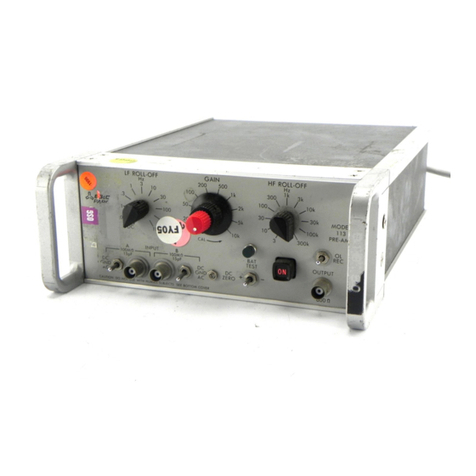
EG&G
EG&G 113 Service manual

EG&G
EG&G ORTEC 572 Service manual
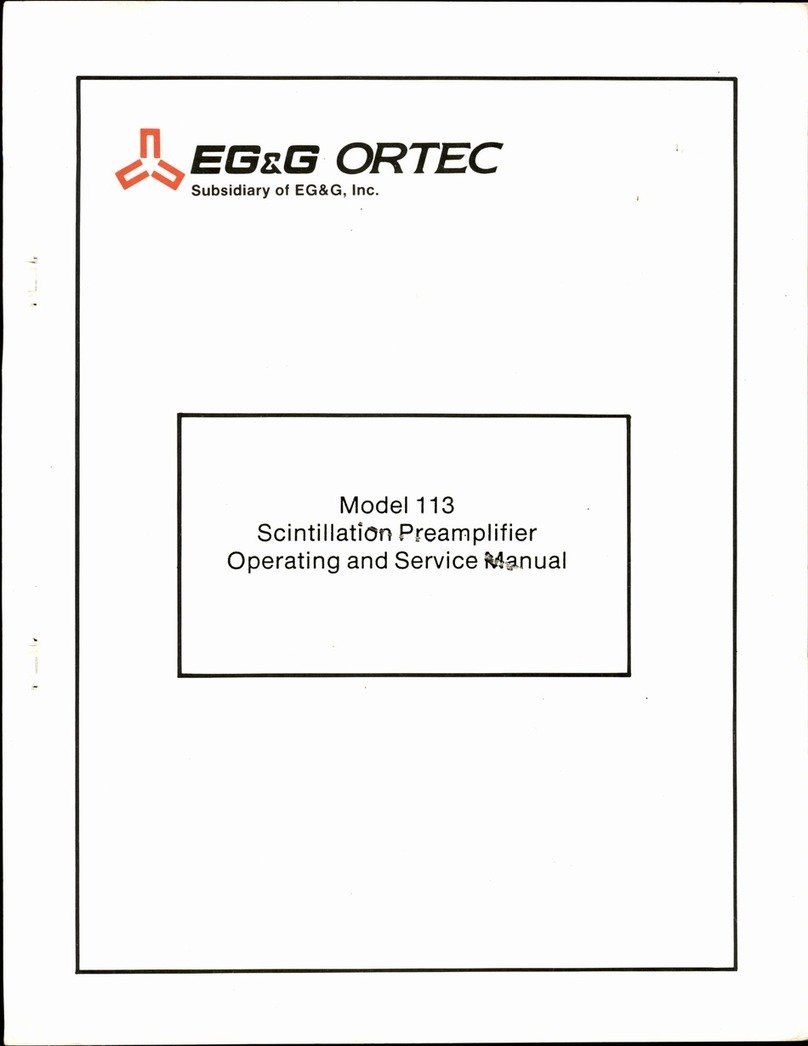
EG&G
EG&G ORTEC 113 Service manual
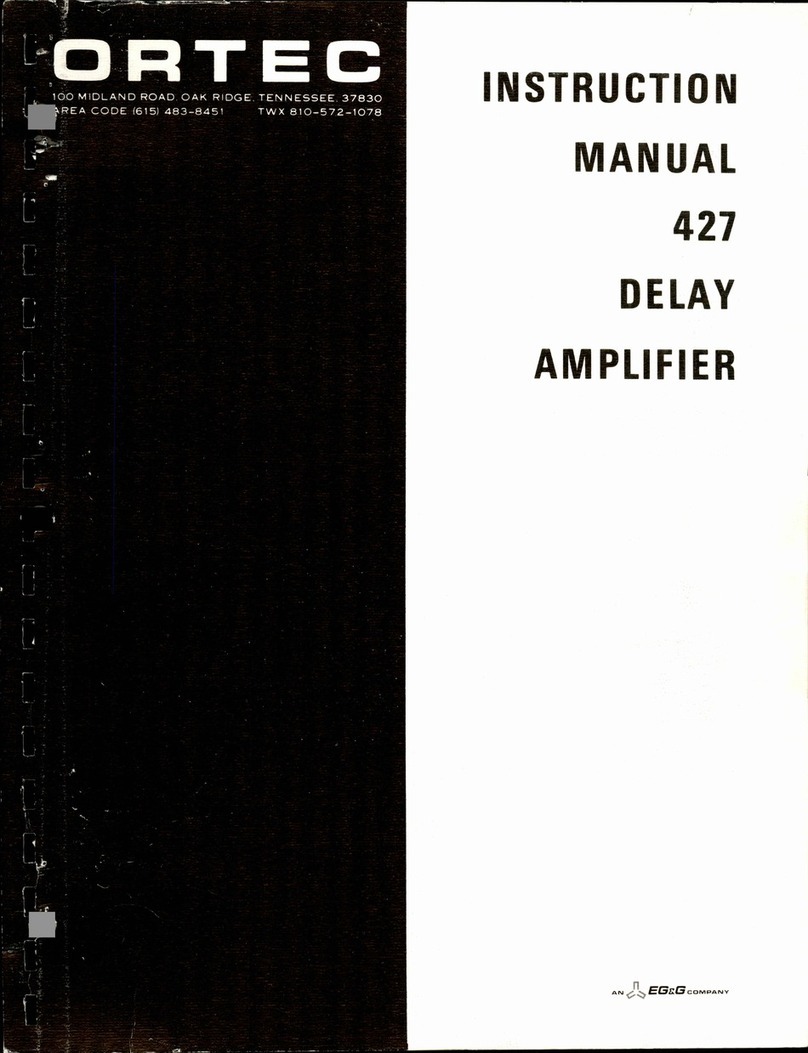
EG&G
EG&G ORTEC 427 User manual
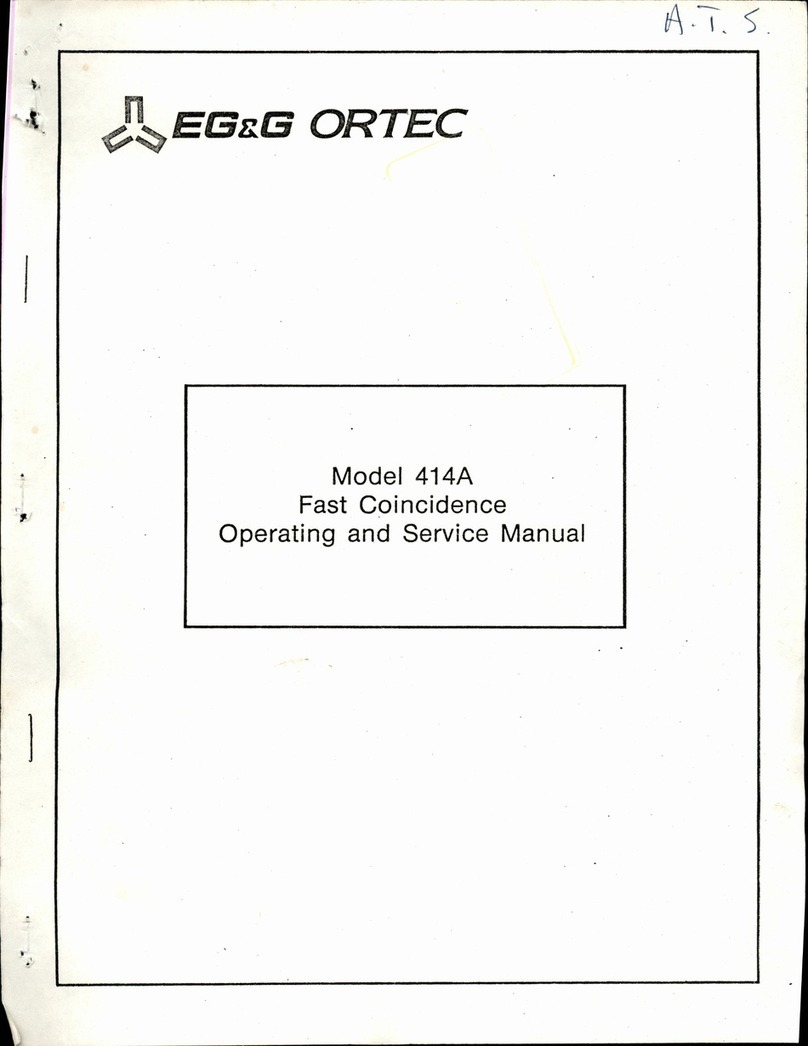
EG&G
EG&G ORTEC 414A Service manual

EG&G
EG&G ORTEC 485 User manual

EG&G
EG&G ORTEC 855 Service manual
